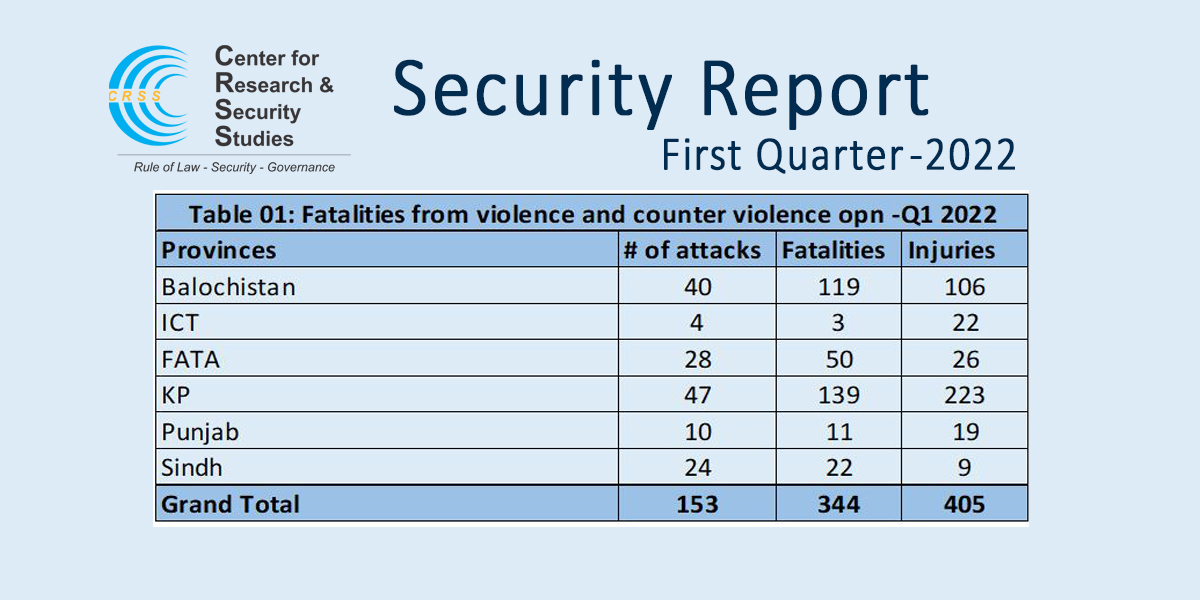Casualties from Violence in Pakistan
During the first quarter of 2022, some 344 people lost their lives and 405 suffered injuries because of violence and counter violence incidents. About 90 % of these victims of violence were from two regions of the country: Balochistan and Khyber Pakhtunkhwa’s border regions. Sindh and the Punjab province experienced a very marginal number of casualties (Table 01).

Fatalities from Violence by Region
Since last year, violence has been on the rise. The first quarter of 2022 saw a 68% rise in violence in general. The KP province witnessed 173% surge in violence, followed by Balochistan (88%) and Sindh (5%). Punjab was the only region registered a decline of 56% in violence (Table 02).
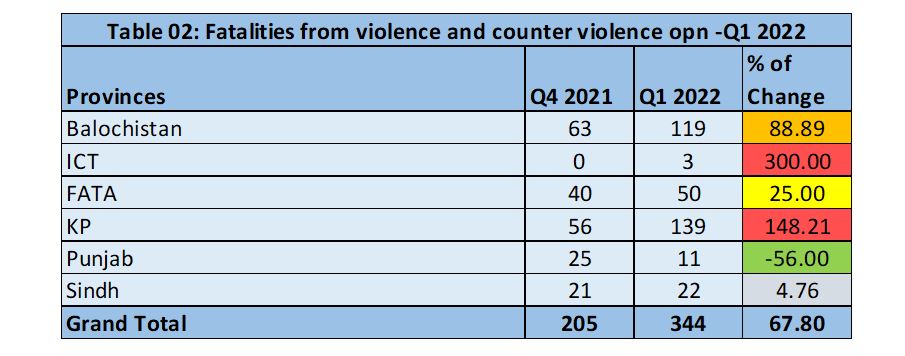
Fatalities from Violence by Month
After a slight decline in January, violent incidents recording a 104% rise in February and 153% in March (Table 03). This sign of a growing trend that can be attributed to the TTP’s new tactics and alliances with some Baloch separatist groups. In December last year, the TTP had refused to extend the ceasefire it had agreed with the government and weeks thereafter saw an unusual surge in violence. Interior Minister Sheikh Rashid had also admitted that the Tehreek-e-Taliban Pakistan (TTP) had escalated its attacks in the country[1].

Fatalities from Violence by Districts
Major incidents of violence took place in Peshawar, North Waziristan, Balochistan’s Kech, Quetta, Sibi, Tank, Nushki districts, and some districts of Karachi where double digit fatalities from violence were recorded. Except Karachi, all other districts are from KP and Balochistan (Table 04).
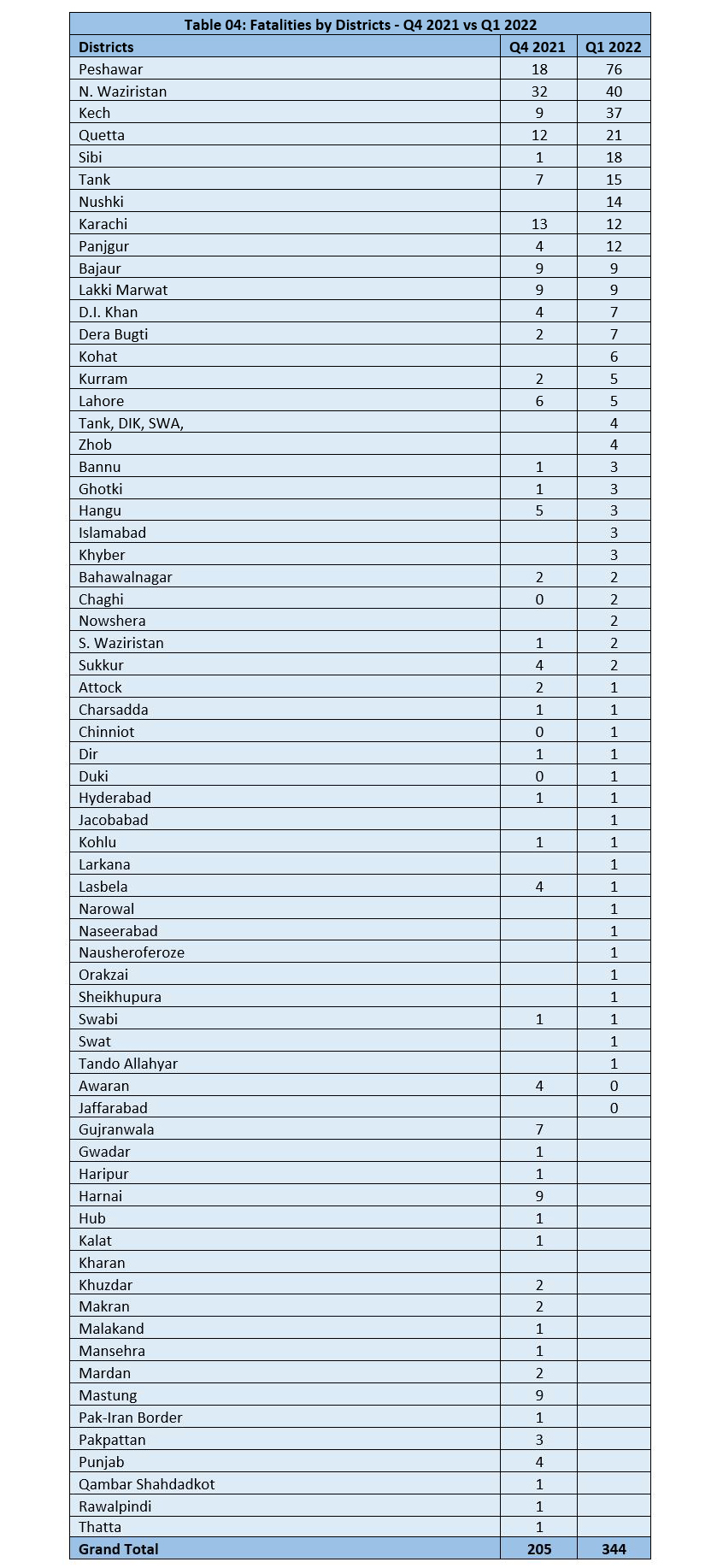
Figure: Fatalities by Districts – Q4 2021 VS Q1 2022

Comparative Fatality Data on Violence/Counter-Violence
A comparative review of violence and counter-violence revealed that at least 13 counter-violence operations by the security forces resulted in fatalities of 18 persons. On the other hand, six terror attacks were thwarted with timely preemptive action by the security forces. Of serious concern is the number of unsuccessful security operations that is higher than the unsuccessful terror attempts (Table 05).

Fatalities from Violence by Type of Victims
Civilians’ casualties were the highest (40%), followed by militants and insurgents (35%), and security personnel (26%). Although the fatalities of militants and insurgents went up by 100% compared to last quarter, it couldn’t bring any respite to the rise in violence (Table 06).
In a media briefing on 5 February 2022, Pakistan’s Ministry of Foreign Affairs said that the Afghan Taliban authorities have been asked to address Pakistan’s security concerns linked to the terror groups including the TTP sheltering in Afghanistan. “We have been raising this matter consistently and we will continue to do that. We expect our concerns to be addressed,” FO spokesman said[2]. As the violence continued unabated in the country, it is obvious that Pakistan’s attempts thus far to elicit action against Afghanistan-based terror groups have remained unsuccessful.
Methods of Violence
Three suicide attacks caused the highest number of fatalities during the first quarter. One suicide attack attempt was thwarted by the timely action of the security agencies leaving the suicide bomber dead in North Waziristan[3]. The other two suicide attacks were better planned as they targeted the populated areas to inflict higher casualties. Ground operations, mostly carried out on the basis of intelligence reports were successful in eliminating some 69 outlaws but some security failures led to civilian fatalities. Terror attacks involving hand-grenades, mortars, landmines and Improvised Explosive Devices (IED) also caused fatalities during this quarter (Table 07).
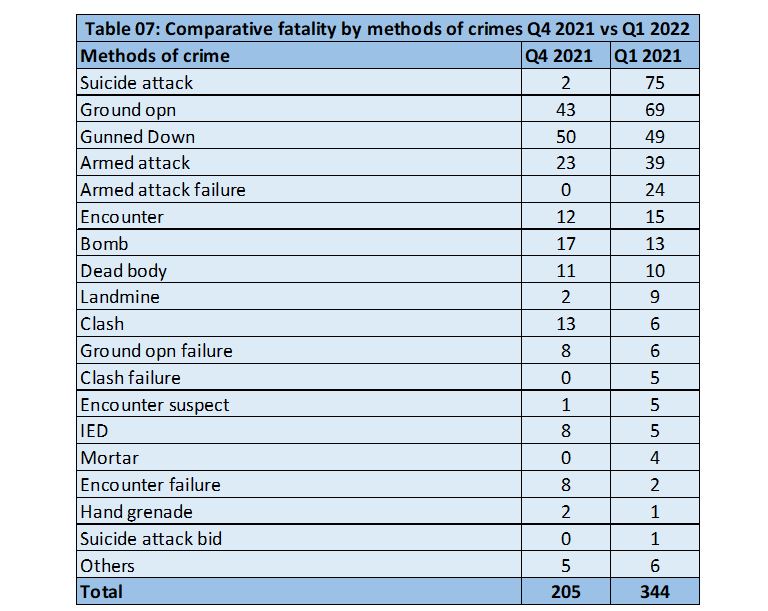
Fatalities Claimed by Militants
Daish or Islamic State claimed to had carried out a deadly suicide attack in Peshawar. The suicide bomber was reported to have been an Afghan national[4], who had received training in Afghanistan before carrying out the attack at the Shia Imambargah in Peshawar. This is an alarming situation that contradicts the Afghan Taliban claim that no terror camps exist in Afghanistan[5]. The insurgent outfit, Baloch Liberation Army (BLA), appeared to have become very active in the country lately and during this quarter, it claimed responsibility for as many as 6 attacks that resulted in 19 fatalities.
TTP claimed responsibility for four terror attacks that left 15 persons dead. A new insurgent group, Baloch Nationalist Army (BNA), made its appearance known in January 2022, when it claimed to had carried out an IED explosion in Lahore’s Anarkali Market, though BLA had also made a similar claim.
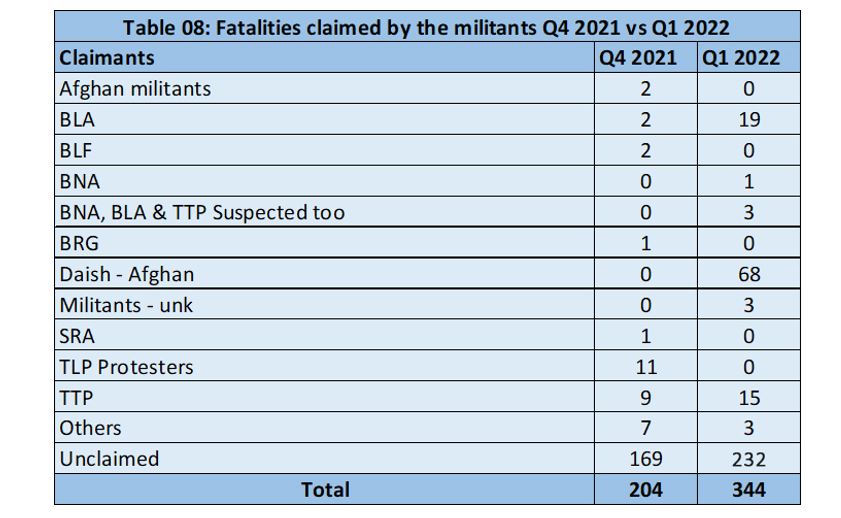
Sectarian Violence
Shia community, a minor sect of the Muslim faith in the country, remains a regular target of violence like other non-Muslim minorities in Pakistan. All victims of sectarian violence during this quarter were from minority communities. (Table 09).
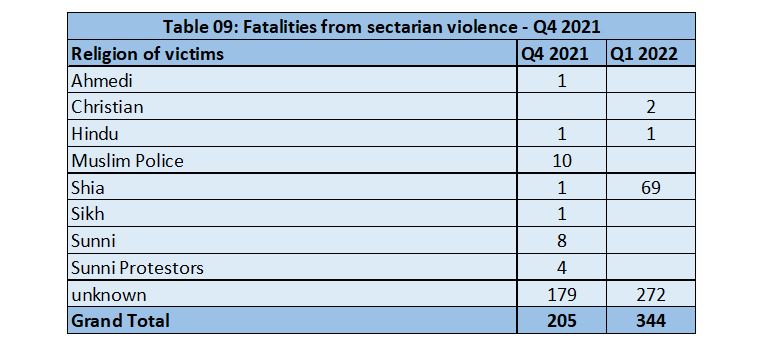
[1] https://tribune.com.pk/story/2341745/ttp-has-stepped-up-attacks-rashid
[2] https://www.dawn.com/news/1673398/foreign-office-asks-taliban-govt-to-address-security-concerns
[3] https://tribune.com.pk/story/2343576/security-forces-kill-terrorist-foil-suicide-attack-bid-in-nw#:~:text=Security%20forces%20have,area%2C%20it%20added.
[4] https://www.thenews.com.pk/print/940180-peshawar-mosque-suicide-bomber-was-afghan-police
[5] https://pajhwok.com/2022/01/11/no-terror-camps-exist-in-afghanistan-govt/

